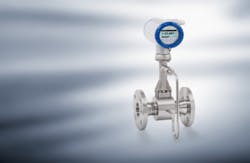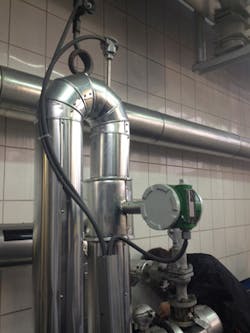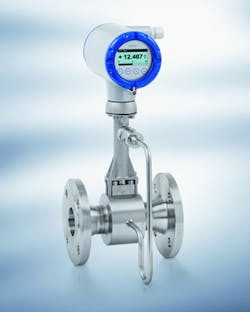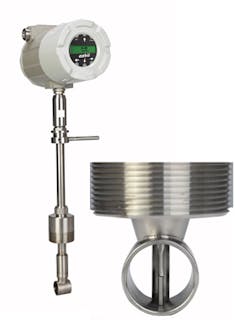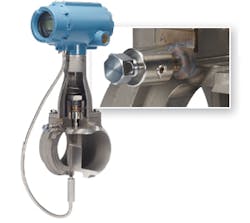Considering the application versatility of vortex flowmeters
Vortex flowmeters are among the most versatile of flowmeters. They can measure liquids, steam and gases with relative ease. One reason they are widely used for steam flow measurement is that they can tolerate the high temperatures of steam. Steam is the most difficult fluid to measure. This is due to the high pressure and high temperature of steam and because the measurement parameters vary with the type of steam. Main types of steam include wet steam, saturated steam and superheated steam.
Steam is often measured in process plants and for power generation. Vortex and differential pressure (DP) flowmeters are the primary meters used to measure steam. Magnetic flowmeters cannot measure steam flow, and Coriolis and ultrasonic flowmeters are just beginning to be used for this purpose. In addition to their ability to tolerate high process temperatures and pressures, vortex meters also have wide rangeability. This allows them to measure steam flow at varying velocities. In process and power plants, steam is often measured coming from a boiler.
READ ALSO: In the Eye of the Vortex—The history and evolution of vortex flow measurement
Multivariable vortex flowmeters are becoming more popular among suppliers and end users. Sierra Instruments is credited with introducing the first multivariable vortex flowmeter in 1997. This meter included an RTD temperature sensor and a pressure transducer with a vortex-shedding flowmeter. By using the information from these sensors, the flowmeter can determine volumetric flow, temperature, pressure, fluid density, and mass flow. Multivariable magnetic flowmeters and multivariable DP flowmeters are also available, while multivariable ultrasonic flowmeters are popular in district heating applications.
Since their introduction in 1997, a number of suppliers have introduced multivariable vortex flowmeters. These include ABB, Yokogawa, Endress+Hauser, KROHNE, Spirax Sarco, Vortek Instruments, and Nice Instrumentation. While multivariable flowmeters are somewhat more expensive than their single-variable counterparts, they enable users to obtain significantly more information about the process than a single-variable volumetric meter. This additional information can result in increased efficiencies that more than make up for the additional cost of the multivariable flowmeter. Multivariable vortex flowmeters also have the capability of measuring mass flow, and this makes them attractive, especially for steam and gas flow measurement.
Multiple mounting types available
Vortex flowmeters are available in flanged, wafer, and insertion styles. Flanged and wafer (inline) styles offer greater accuracy than insertion meters, but are not practical in large line sizes. Vortex meters top out in the 16" range. The "sweet spot" in terms of size for vortex flowmeters is from 1" to 4". Whether a user selects an inline or insertion meter depends on multiple considerations. These include required accuracy and repeatability, line size, fluid type, and the desired supplier or distributor.
While flanged vortex meters are somewhat more expensive than wafer-style meters, they are more secure and provide less opportunity for leakage than wafer-style meters. The longer bolts that are used to secure wafer-style meters have a tendency to expand, creating a possibility of leakage. This could create a safety hazard, potentially resulting in fugitive emissions and lost product. It is easier to install flanged vortex meters correctly than wafer-style vortex meters. Companies that are downsizing may have fewer skilled engineering staff to perform these installations.
Insertion vortex flowmeters
Insertion vortex flowmeters offer a viable option to companies that want to measure flow in large pipes, especially those pipes with an internal diameter greater than 12". Common accuracy levels for insertion vortex flowmeters are in the 1 percent range for liquids and 1.5 percent for steam and gases. Gases and steam are more difficult to measure than liquids for most flowmeter types, although thermal flowmeters are better suited for gas measurements than liquid measurements.
Insertion meters are sometimes used to measure flow in pipes that cannot be shut down. Because insertion meters can be hot tapped, the meters can be swapped out or parts can be replaced without shutting down the line. Inline meters do not have this advantage unless a bypass line is installed, and even so the line has to be shut down to install the bypass line. This gives insertion vortex meters additional flexibility over inline meters.
One reason insertion vortex meters cannot achieve the same accuracy as some inline meters is that they are making a single-point measurement inside the pipe. Some inline meters, such as multipath ultrasonic meters, make multiple measurements and create a calculated average to determine flowrate. Insertion vortex meters make a point measurement and then compute the flow through the whole pipe based on flow profile considerations. The formula used to make this calculation is based on extensive testing and can be improved with time and experience.
Insertion vortex meters compete with insertion magnetic and insertion turbine meters, as well as with averaging Pitot tubes. They have an advantage over insertion magnetic flowmeters, which cannot measure the flow of gases or steam. While insertion turbine meters can be very effective in clean fluids, their rotors and bearings can be damaged by impurities in the flowstream. Vortex meters can handle fluids with impurities, as long as they do not dislodge the bluff body.
Averaging Pitot tubes are often used to measure the flow of air and of stack gases. While single-point Pitot tubes also measure flow at a point, averaging Pitot tubes measure flow at multiple points, and make a total flow measurement based on these multiple measurements. While making multiple flow measurements in a pipe typically produces more accurate results than measurement with a single point, averaging Pitot tubes can be clogged by impurities in the flowstream.
Insertion vortex meters are typically placed in the center of the pipe, where flow velocity is fastest. However, other locations are possible, depending on the measurement configuration. Often, insertion vortex meters are adjustable, allowing them to be used with pipes of different sizes, and they have lower install costs than insertion DP flowmeters.
Interestingly, the top three suppliers of vortex flowmeters, Yokogawa, Emerson Rosemount, and Endress+Hauser, do not manufacture insertion vortex meters. Instead, they have left this market to some of the suppliers with less market share. Examples of suppliers of insertion vortex flowmeters include VorTek Instruments, Spirax Sarco, Oval Corporation, and Nice Instrumentation.
Spirax Sarco introduced its inline vortex meters in 1986 and its insertion vortex meters in 1991. At that time, the company was known as EMCO Flow Systems. EMCO is based in Longmont, Colo., and was acquired by Spirax Sarco of the United Kingdom in 2005.
Founded in 1995, VorTek Instruments specializes in vortex flowmeters, including wafer, flanged, and insertion. The company also sells turbine flowmeters. In January 2013, Azbil acquired a majority stake in VorTek Instruments. Azbil is the Japanese company formerly known as Yamatake Corporation. Since the acquisition, Azbil VorTek has continued to sell its vortex and turbine meters and has also developed a line of ultrasonic flowmeters.
How the vortex flowmeter market thrived
Since their introduction in 1969, vortex flowmeters have had their share of ups and downs. Vibration issues caused a problem for a while, generating false readings. Suppliers addressed this problem by developing advanced software that was able to distinguish between genuine vortices and unrelated disturbances. Measuring very low flowrates remains a problem for vortex flowmeters, since the flow has to be rapid enough to generate vortices. Reducer vortex flowmeters were introduced to generate a stronger vortex signal, especially at low flowrates.
For many years, vortex flowmeters have suffered from a lack of industry approvals. Industry approvals, especially for custody-transfer operations, have greatly helped the growth of the DP, turbine, ultrasonic, magnetic, and Coriolis flowmeter markets. In 2007, a committee of the American Petroleum Institute (API) approved a draft standard for the use of vortex flowmeters for custody-transfer applications. While this draft standard had little initial effect on the market, it was revisited in 2010. It has now been reformulated more specifically as a standard for gas flow measurement. While the future of this draft standard is not completely determined, it will likely have a positive impact on the market.
The future of vortex flowmeters
Frontiers of research for vortex flowmeters include developing higher accuracy and continuing to work on the applicability of vortex meters for steam and gas applications. Expect continued growth in the multivariable vortex flowmeter market. It will interesting to see if any of the "Big Three" suppliers of vortex flowmeters decides to manufacture an insertion vortex meter.
Jesse Yoder, Ph.D., is president of Flow Research Inc. in Wakefield, Mass., a company he founded in 1998. He has more than 27 years of experience as an analyst and writer in process control. Dr. Yoder specializes in flowmeters and other field devices, including pressure and temperature products. Dr. Yoder can be reached at [email protected].
For more on Flow Research’s vortex flowmeter research, see www.flowvortex.com.
Jesse Yoder
Jesse Yoder, Ph.D., is president of Flow Research Inc. He has 30 years of experience as an analyst and writer in instrumentation. Yoder holds two U.S. patents on a dual-tube meter design and is the author of "The Tao of Measurement," published by ISA. He may be reached at [email protected]. Find more information on the latest study from Flow Research, "The World Market for Gas Flow Measurement, 4th Edition," at www.gasflows.com.
